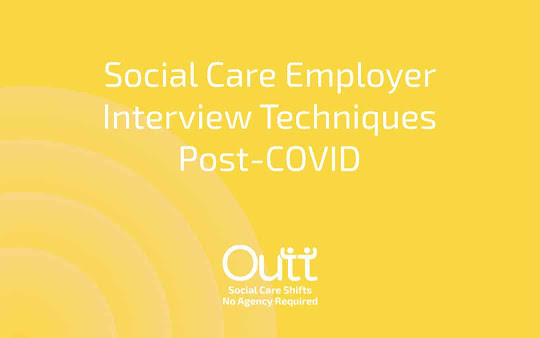SOCIAL CARE EMPLOYER INTERVIEW TECHNIQUES
Every
care home or social care setting will need new staff from time to time. Whether
that is filling full-time roles, covering periods of leave, or using contingent/agency
staff to fill gaps in the staffing rota.
Video
calls are nothing new, but are becoming commonplace, and have changed from
being the exception to the general rule.
Many
social care managers are now:
·
Inviting
candidates to remote interviews via platforms such as Zoom or Skype.
·
Conducting fewer
interview stages to reduce the number of steps in the recruitment process.
·
Interviewing
applicants individually, rather than as part of a panel of hirers.
A
remote call simply isn’t the same as meeting somebody face-to-face. That said,
by preparing well, we can help applicants find the experience less stressful,
and employers gain the essential information they need to make a decision.
The
main challenges of remote interviewing include:
·
Having fewer interview
participants, and thus not having as much of balanced opinion, or not having
colleagues to discuss each applicant with.
·
Not having that
personal interaction with a potential employee to be able to get to know them a
little better.
·
Candidates lack
the benefit of being able to visit a potential workplace to get a feel for the
working environment.
·
Patchy
connections and time delays can make the conversation stilted and
uncomfortable.
ALTERNATIVE SOCIAL CARE RECRUITMENT
TECHNIQUES
As
we learn new ways to communicate and carry out our daily roles, so too has
recruitment needed to pivot.
One
of the essential factors in smooth recruitment techniques is to consider the
best way to reach suitable quality applicants, how to communicate the skill
requirements, salary on offer and job requirements.
The
aims of hiring a new member of staff are unchanged – you want to:
·
Attract the best
possible social care talent.
·
Learn more about
each applicant.
·
Deliver a
pleasant experience for each candidate.
·
Find staff who
fit your requirements and have the right healthcare training.
·
Explain the
detail of the social care jobs on offer, and make it appealing to the right
skill level.
All
of these requirements can be met through digital interviews, provided some
thought and planning go into how best to conduct them.
The
alternatives to traditional face-to-face interviews include options such as:
·
Video interviews
via Zoom, Skype, Teams, Google Meet etc.
·
Telephone
interviews (being mindful that not every applicant may have access to a secure
internet connection).
·
Streaming
real-time workplace virtual tours.
·
Preparing
candidate application packs with more information about the role and work
environment that typically would have been shared during the interview.
·
Informal colleague
chats – sometimes through social media or What’s App – to help applicants ask
questions and meet the team.
With
each of these options, the aim is to replicate the traditional interview and
hiring process, whilst adhering to guidelines around reducing direct contact.
TIPS FOR DIGITAL INTERVIEWS FOR SOCIAL
CARE JOBS
Given
that digital interviews are likely to be as new to an applicant as they are to
an employer, this change is a learning curve for us all.
Here
are our top tips for streamlined, well organized and smooth interview
processes:
1.
Always arrange a
mutually convenient time, and conduct interviews in a quiet place without
interruptions.
2.
Have a list of
questions ready in advance – this also allows you to consult colleagues and
compile a comprehensive list of topics to discuss.
3.
Ensure the same
questions are asked of every candidate, regardless of how the interview is
conducted.
4.
Incorporate extra
time into the recruitment schedule to allow for colleague discussions,
follow-up interviews if necessary and to ensure interviews can be scheduled at
the right time for all participants.
Let’s
look at some of the different interview options, and best practice
recommendations for each medium.
TELEPHONE INTERVIEWS
·
Tell the
applicant what number you will be calling from in advance – it is best to use a
work phone number for a secure and private connection.
·
Confirm the time
of the call, so that they will know to pick up. This is especially important if
you use an undisclosed line, which could be mistaken for a spam call.
·
Decide how many
people will be on the call, and ensure everybody has access to any conference
call links you might be using.
·
Test the line
before the call – nothing makes an interview more stressful than a crackling
connection, a volume that is too quiet or too loud, or time lags after
speaking.
·
It is best to use
a landline rather than a mobile; this avoids potential connection issues or a
breaking signal, and usually prevents those annoying time delays where
participants can end up talking over each other.
VIRTUAL VIDEO INTERVIEWS
·
Whichever
software or app you are using, make sure every participant has access to the
programmed, has it installed in advance, and has logged in or created an
account ready for the interview to begin.
·
Choose the most
convenient option – the most popular include Zoom, Skype, Google Meet, and
Microsoft Teams, although there are many others.
·
If interviewing
with multiple panel members, make sure you have agreed who will lead.
·
Ask all
participants to mute their connection when not speaking. This prevents
background noise from disrupting the flow of conversation.
·
Test the
connection in advance, and always use a stable broadband connection – remote
interviews via mobile are possible but can be less reliable.
·
Make sure the
connection is secure for privacy and security.
·
Always have an
alternative available – such as a telephone interview – as some candidates
might not have access to a computer or laptop, or may not have a reliable
Internet connection.
CARE HOME VIRTUAL TOURS
·
Offer virtual
tours if possible; real-time, live streams are ideal, but pre-recorded videos
are an alternative where this is not possible.
·
Ensure all staff,
visitors, patients, and residents are aware of the video being recorded or
streamed and do not feature anybody who does not wish to be shown.
·
Check that
confidential information is not shared via a video stream; think about notice
boards, paperwork, files, patient name cards on doors etc.
·
Invite attendees
to ask questions, and be involved in the tour process as they would in an
in-person visit.
·
Let everybody
know what programed you will be using – What’s App is a popular choice. If
applicants do not have access to the software or app you are using, try to
offer a pre-recorded video available by other means so that all candidates
receive the same information.
·
Be mindful of
security, and ensure you are using a secure connection and that your virtual
tour is accessible only to invited attendees.
INTERPERSONAL CONNECTIONS IN A
DISTANCED WORLD
When
it comes to social care jobs, interviews are vital to be able to get to
know each applicant. Personal qualities and having a compatible team are just
as important as recruiting social care staff with the right skills and training,
and many of these things can’t be communicated clearly through a written
document. It is still possible to
conduct engaging interviews, and deliver a positive applicant experience
through virtual recruitment – and with the right planning and resources,
workforces can continue to thrive.
Original source :- https://outt.co.uk/social-care-news/social-care-employer-interview-techniques/




Comments
Post a Comment